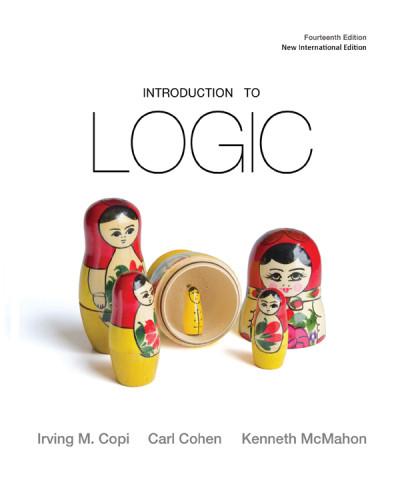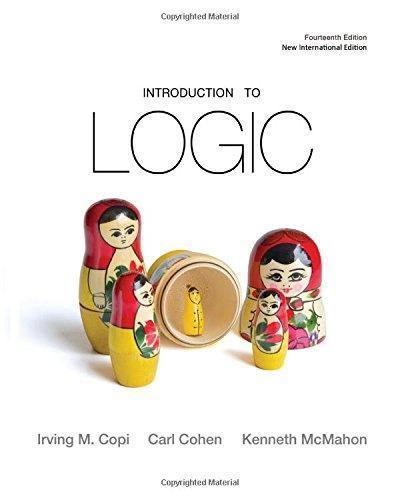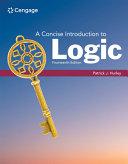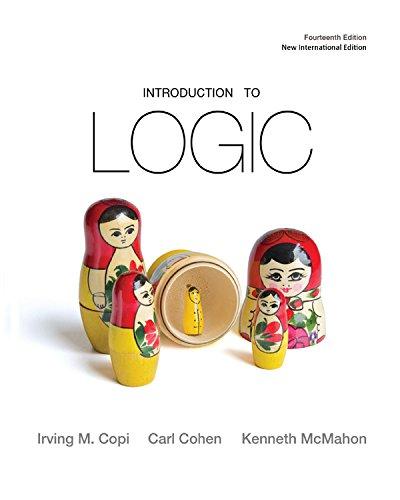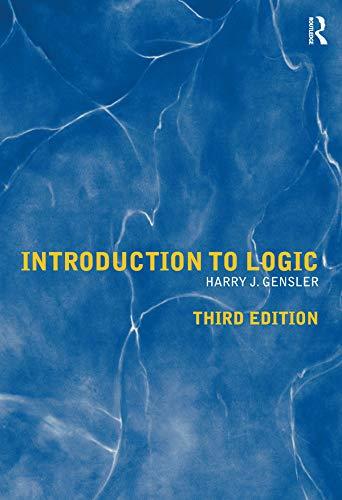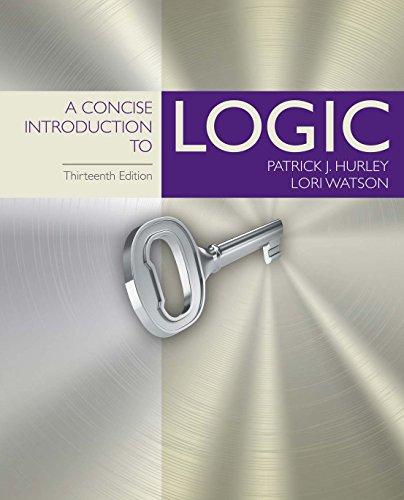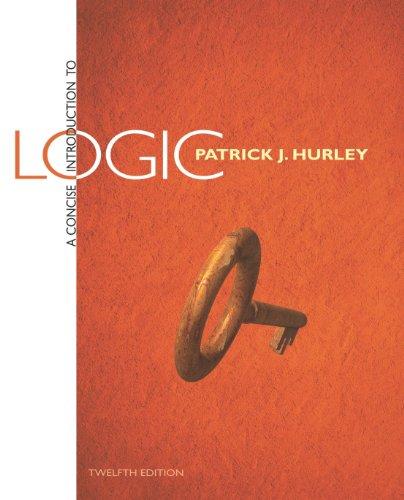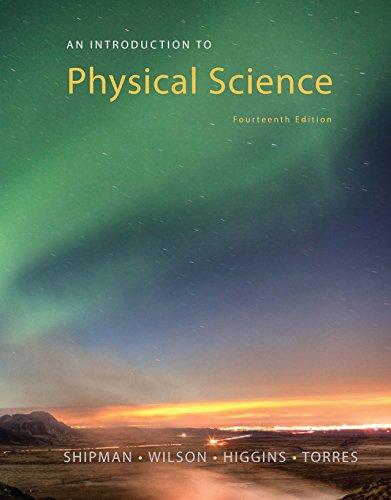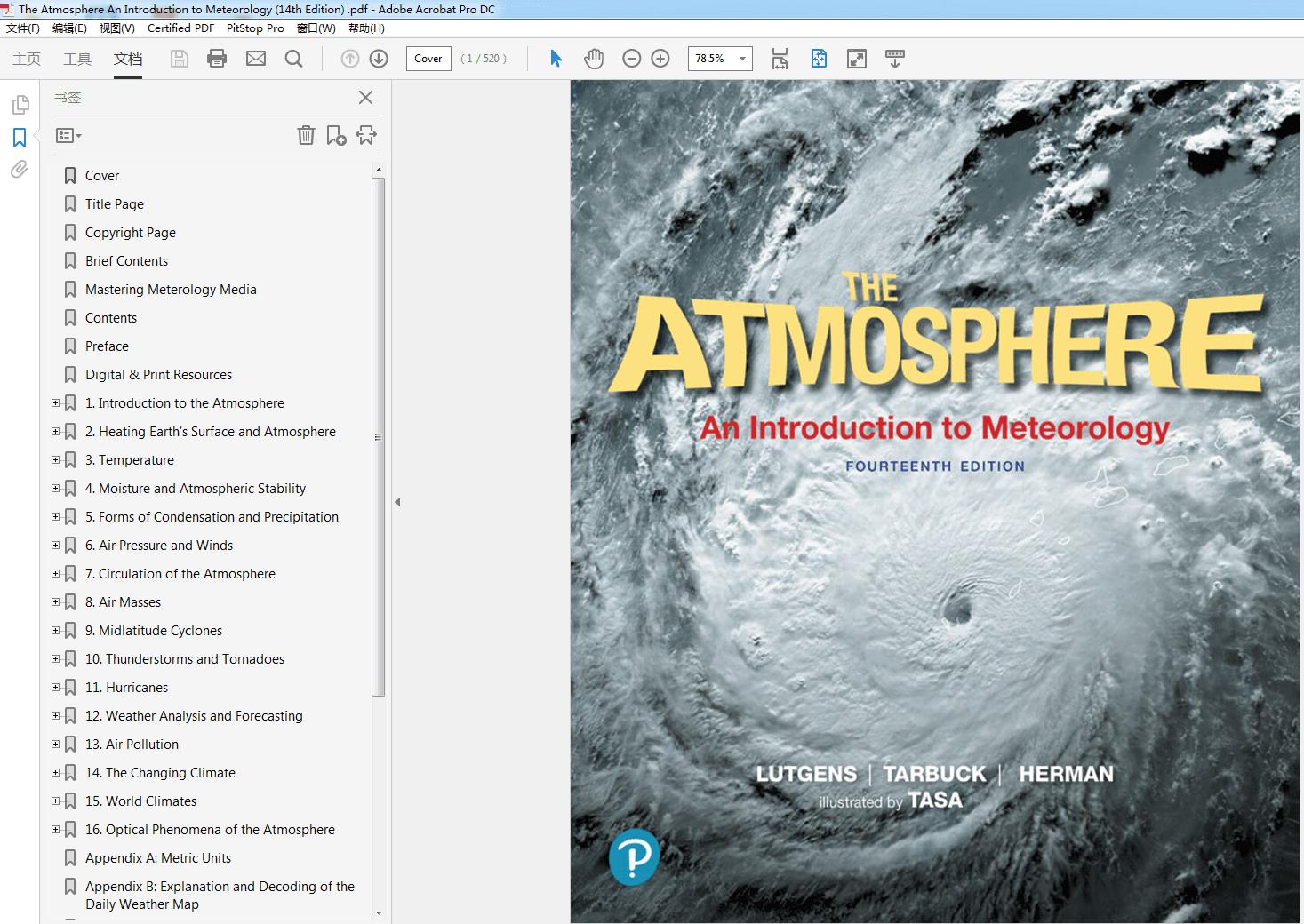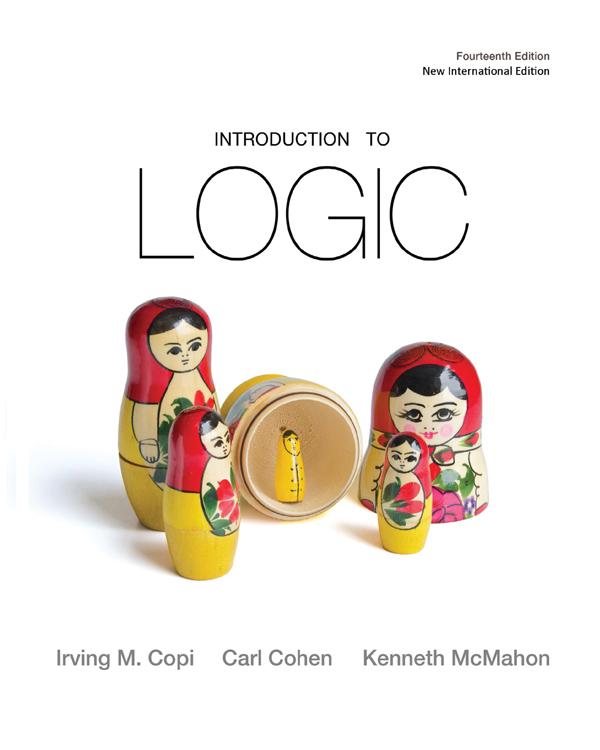Brief Contents
Part I
LOGIC AND LANGUAGE
SECTION A REASONING
chapter 1
Basic Logical Concepts
chapter 2
Analyzing Arguments
SECTION B INFORMAL LOGIC
chapter 3
chapter 4
Part II
Language and Definitions
Fallacies
DEDUCTION
SECTION A CLASSICAL LOGIC
chapter 5
Categorical Propositions
chapter 6
Categorical Syllogisms
chapter 7
Syllogisms in Ordinary Language
SECTION B MODERN LOGIC
chapter 8
Symbolic Logic
chapter 9
Methods of Deduction
chapter 1
Part III
Quantification Theory
0
INDUCTION
SECTION A ANALOGY AND CAUSATION
Analogical Reasoning
Science
Probability
Contents
Foreword
Preface
Acknowledgments
A Very Brief History of Logic
Part I
LOGIC AND LANGUAGE
SECTION A REASONING
chapter 1
Basic Logical Concepts
What Logic Is Propositions and Arguments
Recognizing Arguments
Arguments and Explanations
Deductive and Inductive Arguments
Validity and Truth
chapter 2
Analyzing Arguments
Paraphrasing Arguments
Diagramming Arguments
Complex Argumentative Passages
Problems in Reasoning
SECTION B INFORMAL LOGIC
chapter 3
Language and Definitions
Language Functions
Emotive Language, Neutral Language, and Disputes
Disputes and Ambiguity
Definitions and Their Uses
The Structure of Definitions: Extension and Intension
3.6 chapter 4
Definition by Genus and Difference
Fallacies
What Is a Fallacy?
Classification of Fallacies
Fallacies of Relevance
Fallacies of Defective Induction
Fallacies of Presumption
Fallacies of Ambiguity
Logic in the Real World
Part II chapter 5
DEDUCTION
SECTION A CLASSICAL LOGIC
Categorical Propositions
The Theory of Deduction
Classes and Categorical Propositions
The Four Kinds of Categorical Propositions
Quality, Quantity, and Distribution
The Traditional Square of Opposition
Further Immediate Inferences
Existential Import and the Interpretation of Categorical Propositions
Symbolism and Diagrams for Categorical Propositions
chapter 6
Categorical Syllogisms
Standard-Form Categorical Syllogisms
The Formal Nature of Syllogistic Argument
Venn Diagram Technique for Testing Syllogisms
Syllogistic Rules and Syllogistic Fallacies
Exposition of the Fifteen Valid Forms of the Categorical Syllogism
Appendix: Deduction of the Fifteen Valid Forms of the Categorical Syllogism
chapter 7
Syllogisms in Ordinary Language
Syllogistic Arguments
Reducing the Number of Terms to Three
Translating Categorical Propositions into Standard Form
Uniform Translation
Enthymemes
Sorites
Disjunctive and Hypothetical Syllogisms
The Dilemma
SECTION B MODERN LOGIC
chapter 8
Symbolic Logic
Modern Logic and Its Symbolic Language
The Symbols for Conjunction, Negation, and Disjunction
Conditional Statements and Material Implication
Argument Forms and Refutation by Logical Analogy
The Precise Meaning of “Invalid” and “Valid”
Testing Argument Validity Using Truth Tables
Some Common Argument Forms
Statement Forms and Material Equivalence
Logical Equivalence
The Three “Laws of Thought”
chapter 9
Methods of Deduction
Formal Proof of Validity
The Elementary Valid Argument Forms
Formal Proofs of Validity Exhibited
Constructing Formal Proofs of Validity
Constructing More Extended Formal Proofs
Expanding the Rules of Inference: Replacement Rules
The System of Natural Deduction
Constructing Formal Proofs Using the Nineteen Rules of Inference
Proof of Invalidity
Inconsistency
Indirect Proof of Validity
Shorter Truth-Table Technique
chapter 10
Quantification Theory
The Need for Quantification
Singular Propositions
Universal and Existential Quantifiers
Traditional Subject–Predicate Propositions
Proving Validity
Proving Invalidity
Asyllogistic Inference
Logic in the Real World
Part III
INDUCTION
SECTION A ANALOGY AND CAUSATION
chapter 11
Analogical Reasoning
Induction and Deduction Revisited
Argument by Analogy
Appraising Analogical Arguments
Refutation by Logical Analogy
chapter 12
Causal Reasoning
Cause and Effect
Causal Laws and the Uniformity of Nature
Induction by Simple Enumeration
Methods of Causal Analysis
Limitations of Inductive Techniques
SECTION B SCIENCE AND PROBABILITY
chapter 13
Science and Hypothesis
Scientific Explanation
Scientific Inquiry: Hypothesis and Confirmation
Evaluating Scientific Explanations
Classification as Hypothesis
chapter 14
Probability
Alternative Conceptions of Probability
The Probability Calculus
Probability in Everyday Life
Logic in the Real World
Appendix: Graduate-Level Admission Tests
Solutions to Selected Exercises
Photocredits
Glossary/Index
Foreword
“In a republican nation, whose citizens are to be led by persuasion and not by force, the art of reasoning becomes of the first importance.
—ThomasJefferson”
Logic has sometimes been defined as the science of the laws of thought. This is inaccurate. Thinking is one of the processes studied by psychologists. If thought refers to any process that occurs in people’s minds, not all thought is an object of study for the logician. Thus, one may think of a number between one and ten without doing any reasoning about it. One may also remember, imagine, free-associate, or perform any of a number of mental processes. All reasoning is thinking, but not all thinking is reasoning. The laws that describe the movements of the mind are psychological laws rather than logical principles. To define logic in this way is to include too much.
Logic has also been called the science of reasoning. This is better, but reasoning is a kind of thinking in which inference takes place and conclusions are drawn from premises. This process is extremely complex, characterized by a combination of trial and error, occasionally illuminated by flashes of insight. Logicians are not concerned with the ways in which the mind arrives at its conclusions in the process of reasoning; they are concerned only with the correctness of the completed process: Does the conclusion reached follow by necessity from the premises? The study of the methods and principles used to distinguish correct from incorrect reasoning is the central issue with which logic deals.
Reason is the instrument on which one must depend when reliable judgments are needed. Nonrational instruments—feelings, beliefs, habits, hunches, and the like—are commonly employed, but when a great deal depends on the judgments one makes—when one
must decide how to act in complicated circumstances, or determine what is true in matters that have a serious impact—reason is our best recourse; nothing can replace it.
There are rational methods, methods well tested and confirmed, for determining what is true. There are well-established, rational techniques, for drawing new inferences from what is already known to be true. Our ignorance is vast, and therefore people often resort to some authority in reaching judgment—but the need for reason cannot be escaped even then, because one must decide which authorities deserve respect. Every serious intellectual pursuit comes ultimately to rely on reasoning, because there is nothing that can successfully replace it.
By nature humans are endowed with powers of reasoning. Logic is the study of the uses of those powers. Intuitively, we may have long acted on sound principles, only partly grasped. With care, these principles can be brought to the surface, formulated precisely, and applied with confidence to problems solvable by reason. Through studying logic, people come first to recognize their own native capacities, then to learn to strengthen them through practice. The study of logic helps one to reason well by illuminating the principles of correctreasoning.
Whatever the sphere in which knowledge is sought whether in science, politics, or in the conduct of one’s private life—logic is used to reach warranted conclusions. In the formal study of logic, with which this book is concerned, the student will learn how to acquire truths and how to evaluate competing claims for truth, to critique arguments, recognize inconsistencies, detect logical fallacies, and construct formal arguments according to demonstrably valid inference patterns. In sum, the study of logic will help the student to reason more carefully and, in general, to think and act more rationally.
Ideally, every college course should contribute to this end, yet many do not. Much that is taught in college classes soon grows out of date. But the skills of accurate thinking never become obsolete, and the development of these skills lies squarely within the province of the study of logic. The study of logic helps us to identify
arguments that are good and to understand why they are good. The study of logic helps us to identify arguments that are bad and to understand why they are bad. No study is more useful or more widely relevant to serious concerns than this.
This considered assurance we give to our readers: A command of the fundamental principles of correct reasoning, which the study of this book promotes, will make a deeply satisfying, significant, and permanent contribution to one’s intellectual life.
Preface
Earlier editions of Introduction to Logic have been warmly received by our philosophical colleagues around the world. James Druley from Reedley College, Madera, CA, who was one of the reviewers of the twelfth edition, wrote: “Several times, after reading a part of the text I have thought, ‘That could not have been written any more insightfully or elegantly; that could not have been explained better.’” We are gratified by such kind words, of course, but we are not content. As a consequence, a number of alterations have been made in an effort to refine, polish, and improve an already excellent text. Certain fallacies have been reclassified in Chapter 4, and the flowchart in Chapter 6 has been restructured. In Chapter 8 we have provided and explained alternative symbols that are used in other texts; in addition, much of the material in Chapters 8–10 has been reorganized. Some arguments, definitions, explanations, and formulations have been tightened up and clarified, while the essential structure and substance of the book have been retained.
New to This Edition
In Part One, the basic concepts of logic are presented. We explore the difficulties encountered in everyday uses of language, and the different functions of language. We explain the nature and functions of definitions in ordinary discourse, and then identify and exhibit the many informal fallacies that are commonly encountered. In Part Two the methods of deductive reasoning are presented and analyzed. Here we first give an account of traditional or classical syllogistics, and then introduce the more powerful notation and techniques of modern symbolic logic. Finally, in Part Three, the techniques of inductive logic are presented, beginning with the appraisal of simple analogical arguments and proceeding to an analysis of causal
reasoning, and the canons of scientific method. We conclude with an account of alternative theories of probability, and the uses of the theorems in the elementary calculus of probability.
A short history of logic appears just before the beginning of Part One.
Brief biographies of a number of the great logicians have been included throughout the chapters, both in order to historically contextualize logic, as well as to indicate how contributions to logic are not something remote and detached from life, but an expression of the lives and passions of very human beings.
A new Appendix describes the practical applications of logic to the taking of admissions tests, such as the GRE (Graduate Record Examination), LSAT (Law School Admission Test), GMAT (Graduate Management Admission Test), and MAT (Miller Analogies Test).
Finally, IntroductiontoLogic in all of its editions has been rich with illustrative materials and exercises taken from events and controversies in real life, from history and some classical sources, but mainly from contemporary periodicals and books. We take pride in the fact that, as our reviewers have noted, those studying Introduction to Logic are inescapably introduced to a very wide range of intellectual concerns and thus learn much more than logic. Exhibiting arguments and theories (good and bad) by illustrating them with genuine controversies in the world of college students, rather than with illustrations artificially devised for the purpose, has been our continuing concern. Logical theory is most fully grasped when it is vividly applied to contemporary human affairs. In this edition of Introduction to Logic we have added many fresh illustrations, replacing those more dated, along with some new arguments arising in connection with the lively issues of the first decade of the twenty-first century. In the selection of these illustrations and exercises we seek scrupulously to avoid partisanship. On all sides of controversial issues, good arguments, and bad ones, may appear. Support for one view or another in
current controversy is not our proper business; the understanding and analysis of arguments is.
In all editions of IntroductiontoLogic we strove to achieve that combination of accuracy, clarity, and penetration that has always been our objective. To this end we have relied on the support and advice of students and instructors who use the book and who are sensitive to its shortcomings. We conclude, therefore, with an earnest invitation to our readers to join us in advancing this neverending project. Send us corrections as needed, and suggestions of every kind. Your contributions, warmly welcome, may be most conveniently addressed to Carl Cohen at ccohen@umich.edu or Kenneth D. McMahon at kmcmahon@campus.hpu.edu. The feedback from students and instructors who rely on IntroductiontoLogichas helped to make it the world’s most widely used book in the study of logic. We will receive your responses to it with respect and heartfelt gratitude.
CarlCohen TheUniversityofMichigan,AnnArbor KennethMcMahon HawaiiPacificUniversity,Honolulu
A Note on Color
Logic is often perceived as a “black-and-white” subject. However, in this edition of IntroductiontoLogic we have introduced color. Color plays a role in guiding the eye more readily to sections, subsections, and text boxes, but it also serves important pedagogical functions. In Chapter 6, for instance, color has been used to strengthen the application of the Venn diagram technique for the evaluation of categorical syllogisms. Mastery of this technique is more readily achieved if the circles representing the subject, predicate, and middle terms of categorical syllogisms are consistently positioned relative to each other. Accordingly, previous editions maintained a consistent and predictable placement. This edition strengthens those spatial clues by consistently assigning a specific color to each circle.
This provides an additional visual reminder of the nature of each circle.
Acknowledgments
For accurate corrections, penetrating observations, and wise suggestions in very great number, two persons deserve our heartfelt thanks:
Prof. Victor Cosculluela, Polk State College, Winter Haven, Florida Mr. Manuel Sanchez Nazario, Chicago, Illinois
Contributors to this edition have been very numerous. College students, as well as instructors, have written to suggest improvements, to point out ambiguities or inaccuracies, to note typographical errors, to suggest useful illustrative materials. All receive our direct response, of course; but we take satisfaction in listing here also the names of some of those to whom we are indebted for contributions large and small to this fourteenth edition of IntroductiontoLogic:
Prof. John M. Abbarno, D’Youville College, Buffalo, New York
Prof. Benjamin Abellera, DCF Foundation, Silver Spring, Maryland
Dr. Gerald Abrams, University of Michigan, Ann Arbor, Michigan
Mr. Russell Alfonso, University of Hawaii, Honolulu, Hawaii
Mr. Wyatt Dean Ammon, Hamline University, St. Paul, Minnesota
Ms. Tamara Andrade, Ann Arbor, Michigan
Emil Badici, University of Florida, Gainesville, Florida
Stephen Barnes, Northwest Vista College, San Antonio, Texas
Mr. Jason Bates, University of Michigan, Ann Arbor, Michigan
Mr. Maximilian Bauer, Ann Arbor, Michigan
Mr. George Beals, Michigan Bible School, Plymouth, Michigan
Drew Berkowitz, Bridgewater State University, Bridgewater, Massachusetts
Ms. Amelia Bischof, Ithaca College, Ithaca, New York
Mr. Evan Blanchard, Ann Arbor, Michigan
Mr. Benjamin Block, Ann Arbor, Michigan
Prof. Jeffery Borrowdale, Cuesta College, San Luis Obispo, California
Mr. John Bransfield, University of Connecticut, Storrs, Connecticut
Mr. Nicholas Bratton, Seattle, Washington
Teresa Britton, Eastern Illinois University, Charleston, Illinois
Prof. Keith Burgess-Jackson, University of Texas at Arlington, Texas
Mr. Bryan Campbell, Vanderbilt University, Nashville, Tennessee
Prof. Rebecca Carr, George Washington University, Washington, D.C.
Prof. Sidney Chapman, Richland College, Dallas, Texas
Mr. Kun-Hung Chen, National Taiwan University, Taipei
Prof. Zoe Close, Grossmont College, El Cajon, California
Jennifer Caseldine-Bracht, Indiana University/Purdue University, Ft. Wayne, Indiana
Prof. William S. Cobb, University of Michigan, Ann Arbor, Michigan
Prof. Malcolm S. Cohen, University of Michigan, Ann Arbor, Michigan
Mr. Keith Coleman, University of Kansas, Lawrence, Kansas
Ms. Meredith Crimp, Ann Arbor, Michigan
Mr. Dennis A. De Vera, Dept. of Social Sciences, CAS, CLSU, Philippines
Mr. Joshua De Young, University of Michigan, Ann Arbor, Michigan
James Druly, Reedley College, Madera Center, Madera, California
Prof. Elmer H. Duncan, Baylor University, Waco, Texas
R. Valentine Dusek, University of New Hampshire, Durham, New Hampshire
Mr. Eric Dyer, University of Michigan, Ann Arbor, Michigan
Mr. Kumar Eswaran, Temple University, Philadelphia, Pennsylvania
Mr. Joshua Fay
William Ferraiolo, San Joaquin Delta College, Stockton, California
Ms. Morgan Fett, Ann Arbor, Michigan
Prof. Daniel E. Flage, James Madison University, Harrisonburg, Virginia
Jason Flato, Georgia Perimeter College, Clarkston, Georgia
Prof. Kevin Funchion, Salem State College, Salem, Massachusetts
Ms. Elizabeth Gartner, University of Michigan, Ann Arbor, Michigan
Prof. Faith Gielow, Villanova University, Villanova, Pennsylvania
Prof. Joseph Gilbert, State University of New York at Brockport, New York
Mr. Anand Giridharadas, Mumbai, India
Prof. Sidney Gospe, University of Washington, Seattle, Washington
Mr. Michael Graubert, London, England
Mr. Joseph Grcic, Indiana State University, Terre Haute, Indiana
Dr. Robert A. Greene, University of Michigan, Ann Arbor, Michigan
Ms. Janice Grzankowski, Cheektowaga, New York
Mr. Matthew Hampel, University of Michigan, Ann Arbor, Michigan
Prof. Allan Hancock, Cuesta College, San Luis Obispo, California
Prof. Warren Harbison, Boise State University, Boise, Idaho
Mr. Abdul Halim B. Abdul Karim, of the National University of Singapore
Prof. Clare Swift Heiller, of Bakersfield College, Bakersfield, California
Prof. Jeremiah Joaquin, De La Salle University, Manila, Philippines
Prof. Royce Jones, Illinois College, Jacksonville, Illinois
Prof. Gale Justin, California State University at Sacramento
Mr. Rory Kraft, Jr., Michigan State University, East Lansing, Michigan
Prof. Richard T. Lambert, Carroll College, Helena, Montana
Mr. Charles Lambros, State University of New York at Buffalo
Mr. Andrew LaZella, Hamline University, St. Paul, Minnesota
Prof. Gerald W. Lilje, Washington State University, Pullman, Washington
Mr. James Lipscomb, Tarrytown, New York
Ms. Linda Lorenz, Ann Arbor, Michigan
Prof. E. M. Macierowski, Benedictine College, Atchison, Kansas
Ms. Erika Malinoski, University of Michigan, Ann Arbor, Michigan
Prof. Krishna Mallik, Bentley College, Waltham, Massachusetts
Mr. Neil Manson, University of Aberdeen, United Kingdom
Prof. Edwin Martin, North Carolina State University, Raleigh, North Carolina
Prof. Michael J. Matthis, Kutztown University, Kutztown, Pennsylvania
Prof. George Mavrodes, University of Michigan, Ann Arbor, Michigan
Prof. Leemon McHenry, Wittenberg University, Springfield, Ohio
Mr. Christopher Melley, Univ. of Maryland, Asian Division, Okinawa, Japan
Ms. Medeline Metzger, Ann Arbor, Michigan
Mr. David A. Mihaila, Honolulu, Hawaii
Prof. Richard W. Miller, University of Missouri at Rolla, Missouri
Prof. Masato Mitsuda, San Francisco State University, San Francisco, California
Ms. Erin Moore, Ohio State University, Columbus, Ohio
Ms. Susan Moore, Fairgrove, Michigan
Prof. Kippy Myers, Freed-Hardeman University, Henderson, Tennessee
Mr. Michael North, University of Michigan, Ann Arbor, Michigan
David O’Connor, Seton Hall University, South Orange, New Jersey
Mr. John Oltean, Ann Arbor, Michigan
Prof. Sumer Pek, University of Michigan, Ann Arbor, Michigan
Prof. Ray Perkins, Plymouth State College, Plymouth, New Hampshire
Mr. Robert Picciotto, Gastonia, North Carolina
Prof. Howard Pospesel, University of Miami, Coral Gables, Florida
Mr. Wayne Praeder, of the U.S. Chess Federation
Ms. Deborah Pugh, Stanford, California
Prof. Dennis P. Quinn, St. Vincent College, Latrobe, Pennsylvania
Mr. Nicholas Quiring, University of Michigan, Ann Arbor, Michigan
Mr. Chris Raabe, of Yakatut, Alaska
Mr. Jay Rapaport, University of Michigan, Ann Arbor, Michigan
Dr. Patrick Rarden, Appalachian State University, Boone, North Carolina
Prof. Lee C. Rice, Marquette University, Milwaukee, Wisconsin
Dr. Thomas Riggins, New York University, New York City
David C. Ring, Orange Coast College, Costa Mesa, California
Prof. Blaine B. Robinson, South Dakota School of Mines, Rapid City, South Dakota
Eric Saidel, George Washington University, Washington, D.C.
Rudy Saldana, Citrus College, Glendora, California
Mr. Milton Schwartz, Esq., New York City
Mr. Amit Sharma, of V. S. Niketan College, Kathmandu, Nepal
Prof. Emeritus Albert C. Shaw, Rowan College, Glassboro, New Jersey
Prof. Edward Sherline, University of Wyoming, Laramie, Wyoming
Mr. Amjol Shrestha, Hawaii Pacific University, Honolulu, Hawaii
Ms. Lauren Shubow, University of Michigan, Ann Arbor, Michigan
Mr. Jason A. Sickler, University of North Dakota, Grand Forks, North Dakota
Ms. Stefanie Silverman, University of Michigan, Ann Arbor, Michigan
Prof. Michael Slattery, Villanova University, Villanova, Pennsylvania
Dr. Barbara M. Sloat, University of Michigan, Ann Arbor, Michigan
Mahadevan Srinivasan, University of Tennessee, Knoxville, Tennessee
Prof. James Stewart, Bowling Green State University, Bowling Green, Ohio
Mr. Paul Tang, California State University, Long Beach, California
Mr. Andrew Tardiff, North Kingstown, Rhode Island
Mark L. Thomas, Blinn College, Bryan, Texas
David A. Truncellito, George Washington University, Washington, DC
Ms. Meghan Urisko, Ann Arbor, Michigan
Mr. J. A. Van de Mortel, Cerritos College, Norwalk, California
David Vessey, Grand Valley State University, Allendale, Michigan
Mr. Chris Viger, University of Western Ontario
Mr. Roy Weatherford, University of South Florida, Tampa, Florida
Prof. Allen Weingarten, Morristown, New Jersey
Prof. Warren Weinstein, California State University at Long Beach, California
Ms. Jessica Wheeler, Springfield, Missouri
Prof. Philip H. Wiebe, Trinity Western University, British Columbia, Canada
Mr. Michael Wingfield, Lake Dallas, Texas
Mr. Isaiah Wunsch, University of Michigan, Ann Arbor, Michigan
Ms. Cynthia Yuen, Ann Arbor, Michigan
Maria Zaccaria, Georgia Perimeter College, Dunwoody, Georgia
A Very Brief History of Logic
Philosophy begins with wonder. What is the world made of?
Where does it come from? Why are we here? The speculations of primitive peoples were often imaginative, but were unfounded, irrational. Philosophy as we think of it today did not arise until the Greek philosophers of the sixth century BCE sought some overriding theories about the world. Is there one stuff of which the world is made? One principle that is fundamental throughout?
We think of Socrates and Plato as the great figures in the birth of Western philosophy, and we study them still today. Their greatness lies in part in their efforts to bring things into intellectual order—to provide, or at least to seek, some coherent system that can explain why things are the way they are. But even before Socrates there had been deep thinkers—Thales, Parmenides, Heraclitus, Democritus and others who had proposed assorted accounts of the fundamental stuff of the world, or of the fundamental principle by which all is governed.
They were theorizing, not merely guessing—but there was no real science in these early speculations. Dogmatic suppositions, supernatural forces, the gods, ancient myths and legends had always to be called upon. As philosophy gradually matured there grew the drive to know, to discover principles that could be relied upon in giving explanations.
Thus logic begins. Judgments are sought that can be tested and confirmed. The methodswith which we discover and confirm whatever we really know need to be identified and refined. We must reasonabout things, and we hunger to understand the principles of right reasoning.
That first climb from chaotic thought into some well-ordered system of reasoning was an enterprise of extraordinary difficulty. Its first master, Aristotle (see p. 3), having developed a system within which the principles of reasoning could be precisely
